
Picturesque canal across the Kintyre peninsular. Opened in 1801 to shorten the route between the Clyde and Hebrides. Designed by John Rennie with later improvements by Thomas Telford.
Crinan Sea Lock
Crinan
Lochgilphead
Once described as 'the most beautiful shortcut in the world', the 14.5 km (9 miles) long Crinan Canal was constructed over two hundred years ago by a private company headed by the Duke of Argyll. Created to open up the West Coast and improve access to the Western Isles (see entry for Tobermory Harbour), it offered a safe transit route from Ardrishaig on Loch Fyne to Crinan, thus avoiding the often difficult and potentially dangerous sail around the Mull of Kintyre and cutting over 160km (100 miles) off the journey time.
In 1771, James Watt surveyed the district to find a course for the canal, originally planned by John Rennie. The Crinan Canal Act was passed in 1793, and Thomas Telford superintended the execution of the work. Funding for the canal came from London as well as Glasgow, but the money ran out in 1801. Government loans and additional funding finally allowed the canal to be finished in 1809.
In conjunction with the Lowlands system of canals (the Forth & Clyde, Monkland, and Union Canals) and the Caledonian Canal, it provided sheltered water communication between the Firth of Forth, Edinburgh and Central Scotland, Glasgow and the Firth of Clyde, as well as the western and northern areas of Scotland, from Argyll to the Moray Firth. At this time, there were no railways, and only military roads in the Highlands.
In 1823, a section of the canal bank approximately three miles north of Ardrishaig failed, and the course of the canal was altered to avoid the marshy ground which had caused the problem. The old banks may still be seen between the canal and the main road to Oban. Worse came in 1859, when a reservoir dam burst and millions of litres of water and hundreds of tonnes of rocks, boulders, peat and mud were discharged for thirty minutes from high above the canal into the summit reach. From there it spread in both directions, wrecking locks, pounds, public road and canal banks. Miraculously, there was no loss of life.
Given these misfortunes, it is of no surprise that the Crinan Canal never became financially self-supporting. By 1854, the canal was carrying 33,000 passengers, 27,000 sheep and 2,000 cattle: by 1906 most of the revenue was obtained from goods traffic, but at £6,000 a year this hardly covered operating costs. Nonetheless, it has been retained as a local amenity, and as a vital supply line to the Highlands and Islands. Between 1930 and 1932, new sea locks were constructed at either end, making the canal accessible at any state of tide. Lock 14 and the canal bank between Crinan and Bellanoch were extensively improved as recently as 1991, in an effort to reduce the amount of water lost through leakage.
The canal is now used extensively by yachts as well as fishing vessels. For many years, some of the most prominent sights on the canal were the Clyde Puffers - little cargo vessels that designed to fit the Forth & Clyde and Crinan Canals. They delivered coal to the West Coast, bringing back whisky and other produce. Today there are only three puffers left on the West Coast; Vic 32 based at the canal basin in Crinan is in commision and offers trips to tourists. Auld Reekie (ex VIC 27) is being restored at Crinan Boatyard and Eilean Eisdeal (ex VIC 72), in commision, is at Inverary. Vic 96, in commission, is based at Chatham docks.
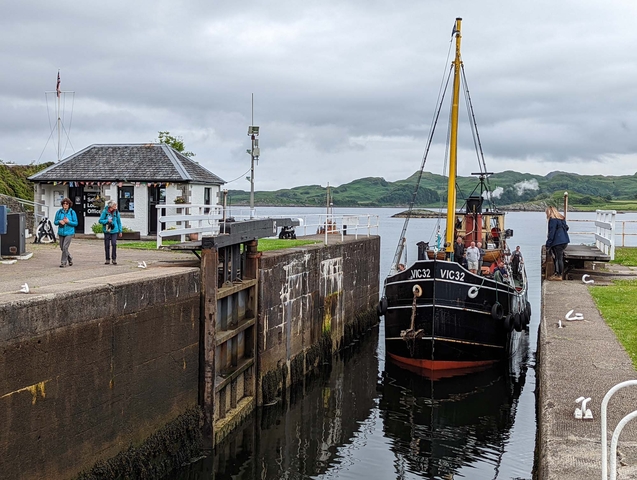
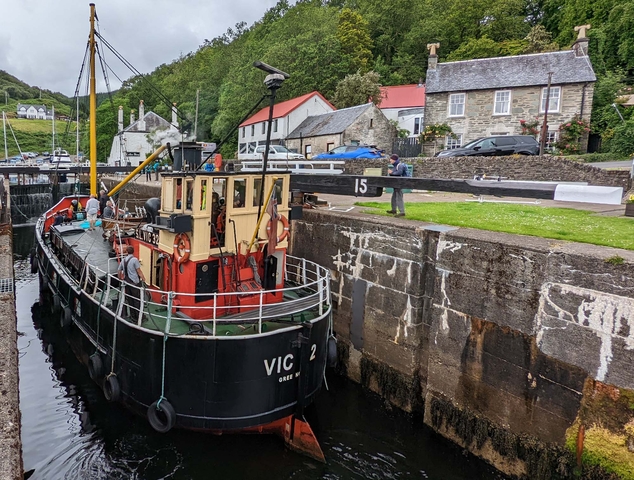
Vic 32 enters Crinan sea lock - June 2022
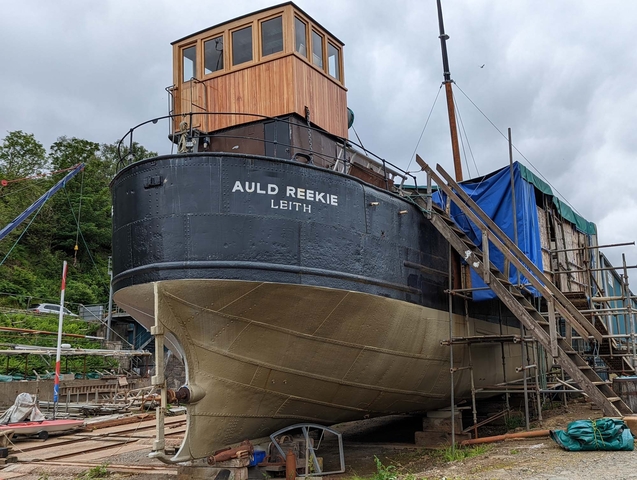
Auld Reekie under restoration, Crinan Boatyard, June 2022
The canal itself no longer carries freight, although the harbour at Ardrishaig is an important element in Scotland's timber trade. Approximately 30,000 tonnes currently pass through the harbour each year, but a programme of refurbishment and modernisation has boosted annual capacity to 150,000 tonnes.
The Red Wheel Heritage Plaque was unveiled by John Cameron CBE and Chris O'Connell on Saturday 15th April 2023 accompanied by John Yellowlees
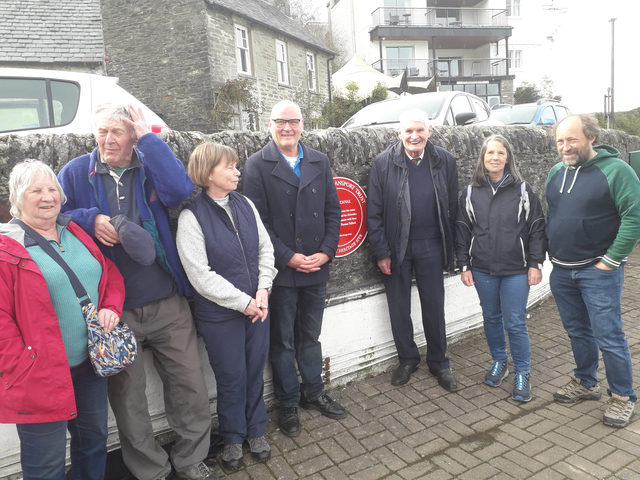
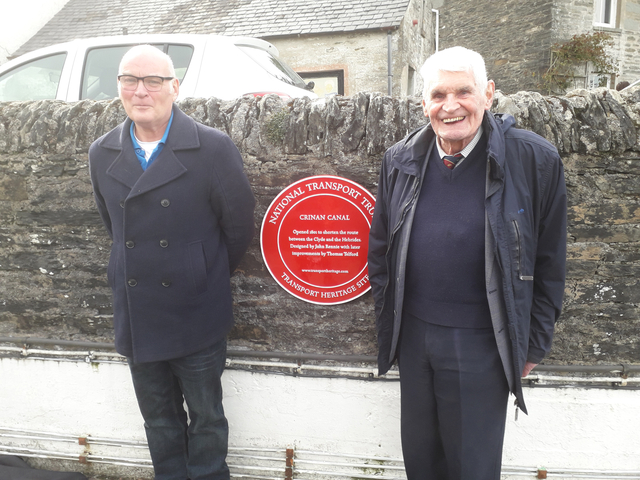
Photos: Elliot Witherow DL, Alan Armstrong, John Yellowless - with thanks
By road: On A83 in Ardrishaig. The canal can be followed on A816 and then B841 to its junction with B8025, where an unmarked road leads to the western end at Crinan.

Bartholomew, Nicholson Inland Waterways Map of Great Britain, ISBN 978-00072 11173 (2006)
Boughey, Joseph, Hadfield's British Canals: the Inland Waterways of Britain and Ireland, Alan Sutton, ISBN 978 18401 50247 (1998)
Boughey, J. and Hadfield, C., British Canals: A Standard History, Alan Sutton, ISBN 978-07524 46677 (2008)
Burton, A., The Waterways of Britain, Collins, ISBN 0 00 218047 2 (1983)
Gladwin, D.D., A Pictorial History of Canals, Batsford, ISBN 0 7134 0554 6 (1977)
Hutton, Guthrie, The Crinan Canal: Puffers and Paddle Steamers, Stenlake Publishing, ISBN-10: 1872074375 (1994)
Hutton, Guthrie, Crinan Canal - the Shipping Short Cut, Stenlake Publishing, ISBN-10: 1840332573 (2003)
Lindsay, Jean, The Canals of Scotland, David & Charles, ISBN 0-7153-4240-1(1968)
MacDougall, Leslie, The Crinan Canal: Illustrated History and Guide, Northern Books, ISBN-10: 0905489187 (1972)
Miller, Moira, Through the Crinan Canal: And the Canals of Scotland, Scottish Children's Press, ISBN-10: 1899827420
Monroe, Neil, Para Handy Tales - published in many editions since 1903- see Amazon
Pratt, D., Waterways Past and Present: A Unique Record of Britain's Waterways Heritage, ISBN 978-07136 76341 (2006)
Pratt, F., Canal Architecture in Britain, Shire, ISBN 978- 09032 18139 (1976)
Roberts, B., Britain's Waterways: A Unique Insight, GEOprojects, ISBN 978- 08635 11158 (2006)
Ware, M.E., Britain's Lost Commercial Waterways, Landmark, ISBN 978-18430 61816 (2005)
Dolphin,Ben., Tale of Two Canals August 2021